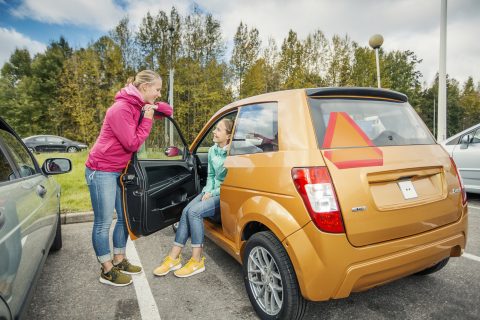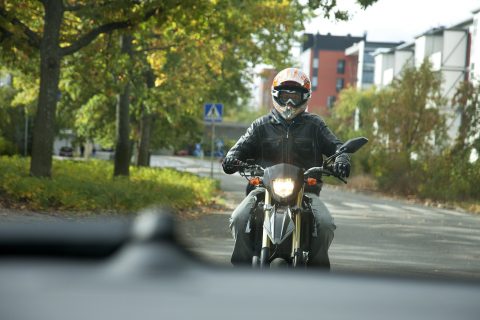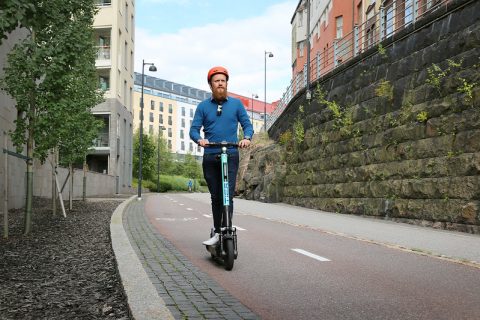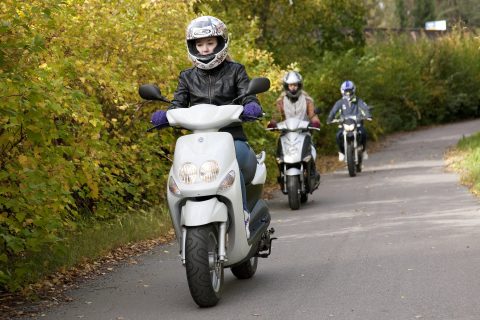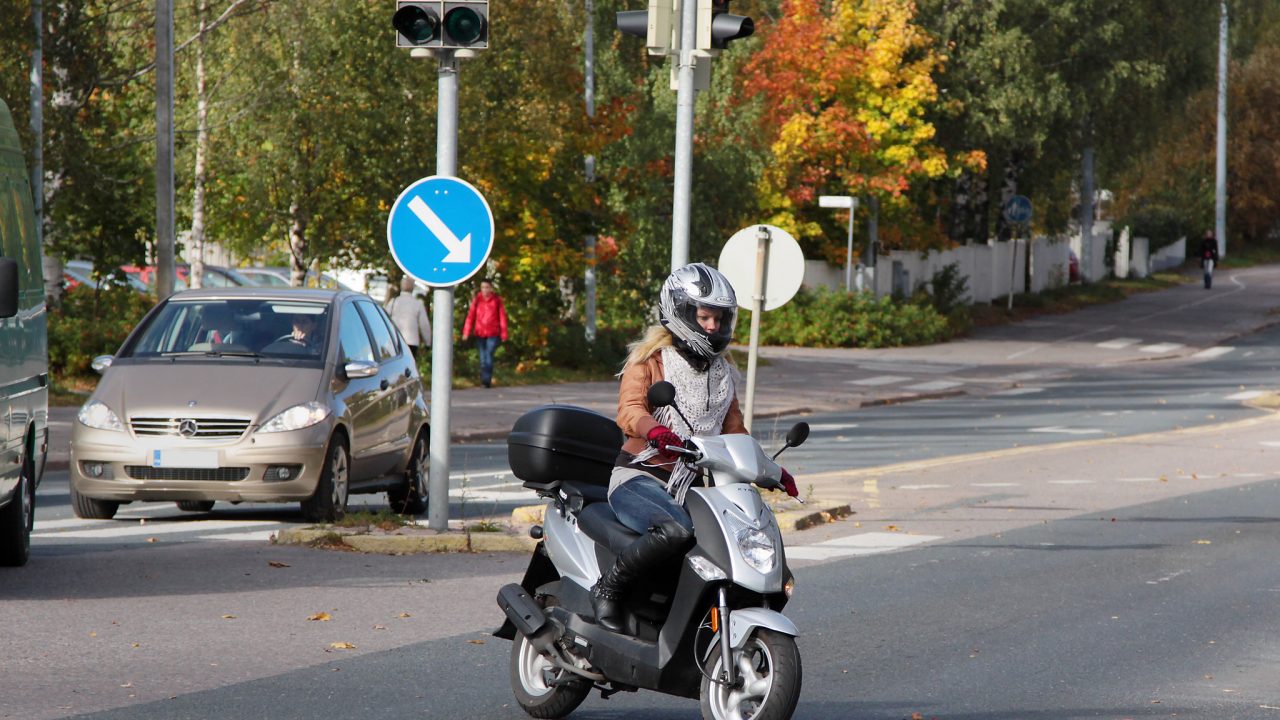
Mopeds
Mopeds and quadricycles are popular vehicles among young people, but they can also be used by the whole family. Driving a moped is an important first step in learning traffic rules and a safe attitude on the road.
Driving a moped
Moped drivers must be at least 15 years old and have at least an AM120 category driving licence.
As a moped driver you are in charge of a motor vehicle with largely similar responsibilities and rights as car drivers. You must not allow your driving ability to be affected by driving under the influence of alcohol, drugs or controlled medicines or when tired. You must stop when requested to do so by the police and allow both yourself and your vehicle to be checked for driving ability and roadworthiness.
Passengers on mopeds
The moped was originally designed for one person. As a result of technical developments, an adult passenger can now also be transported by a moped if the registration certificate so indicates. If there is no mention of transporting a passenger on the registration certificate, only one child up to 10 years of age may be transported on the moped, provided that the child has an appropriate seat and leg protection. A child may only be transported if it can be reliably ensured that they will remain securely seated. In other words, it is essential that the possibility of transporting a passenger is indicated in the registration certificate. Note also that the driver should have good control of the moped when transporting a passenger. Do not carry a passenger who is not appropriately equipped. Don’t forget that a helmet is also compulsory for a moped passenger.
Controlling a moped
Controlling a two-wheeled vehicle is actually more demanding than driving a car. Speed is the single most important factor for controlling safety. Speed is often a contributing factor that can influence
- the ability to observe the surroundings accurately
- the ability to control the moped
- the stopping distance
- the severity of consequences in the event of a collision or fall.
The most important skill to practise on a moped is effective braking. Effective braking requires simultaneous operation of the front and rear brakes. It is particularly important to be able to use the front brake efficiently but safely. When braking only with the rear brake, the braking distance may be up to three times that of combined braking. When carrying a passenger, the centre of gravity of the moped shifts rearward and the traction of the front tyre decreases. This makes braking and steering more difficult.
Stopping distance
The effect of speed is particularly evident in slowing down and stopping the moped. The stopping distance always consists of two factors, the reaction distance and the braking distance. The reaction distance is the distance travelled from the driver’s perception to the start of braking. If the driver’s reaction time is two seconds, the moped will travel about 22 meters during those two seconds when driving at a speed of 40km/h, i.e. the speed will not be reduced at all during that time. Drivers are able to react in about a second in a test situation, but in real traffic the reaction time is longer. The driver’s reaction time is prolonged by the use of alcohol, drugs or controlled medicines, fatigue and the characteristics of the situation, e.g. unexpectedness.
The length of the braking distance is mostly affected by the vehicle’s speed. The second most important factor is the driver’s braking performance. The condition of the brakes and tyres and the adhesion characteristics of the road surface also have a significant impact on the braking distance. It is worth remembering that even a small reduction in speed gives a lot more room for manoeuvre. For example, reducing the speed from 40km/h to 30km/h halves the braking distance.
Basic tips for safe moped driving
- Know the rules and follow them.
- Know yourself and your vehicle.
- Take other road users into account.
- Use an appropriately sized, intact helmet and fasten the strap. A moped passenger must also wear a helmet.
- Drive proactively: adjust speed according to the situation, observe your surroundings, avoid making unexpected moves and maintain safe distances.
In terms of safety, it is also important to remember that
- A moped driver is in charge of a motor vehicle, with largely similar responsibilities and rights as car drivers.
- Driving a tuned moped is a safety risk and prohibited by law.
- Wear protective and visible clothing when driving.
- Check your driving ability before starting your journey. Driving a moped while drunk is a DUI offence just like with other vehicles.
- When approaching a pedestrian crossing, the speed must be adjusted to a level that allows for stopping if necessary.
- When changing lanes, do not cause harm or danger to other road users.
- Mopeds should stay on the hard shoulder or to the right-hand edge of the road. From 1 June 2020, mopeds can be driven on the hard shoulder only outside populated areas. Cycleways may be used only if specifically permitted and indicated.
- Choosing the appropriate route is especially important when driving a moped or quadricycle. Take into account speed limits, traffic volumes and conditions.
- Monitoring and anticipating rear traffic is important. Queues and risky overtaking often happen behind you.
- Learn to spot important factors.
- Learn what to do in the event of an accident.
Moped accidents are often caused by moped drivers’ dangerous driving habits
The number of moped accidents has fallen in recent years. There are approximately three fatalities and 360 injury cases per year. Road safety education is especially important, as accidents are often caused by moped drivers’ dangerous driving habits.
The risk of dying in a road accident for 15–17-year-olds is higher in Finland compared to other Nordic countries. Young males’ accidents in this age group typically involve mopeds. The risk of a serious traffic accident is over ten times higher for mopeds compared to cars. Moped drivers are often ignorant of the rules, or they take unnecessary risks, want to show off or have disregard for other road users. Moped drivers are also unprotected and difficult to spot. Mopeds can travel relatively quickly and surprise other road users.
Many minor accidents are not included in the statistics, so in reality there are more accidents than what is reported. The majority of moped accidents are caused by the moped drivers themselves. Accidents typically happen in intersections, but there are also derailments, falls and rear-end collisions. One in five serious moped accidents involve a drunk driver.
Quadricycle accidents have many similarities with moped accidents and accidents involving young car drivers. Inexperienced drivers have difficulty controlling the vehicle speed, especially in situations where it is necessary to adjust speed in different types of bends and turns. Driving skills are put to the test, which is reflected in the increasing number of derailments. Be mindful that quadricycles are not as safe as cars in accidents.
Tuning a moped is prohibited and may lead to significant cost
Many moped drivers would like to go faster than what is permitted, but modifying a moped can turn it into a dangerous vehicle. It is not permitted to alter the structure of a vehicle used on roads in any way that makes it non-compliant with the relevant requirements.
It is illegal to drive a tuned moped on public roads. A tuned moped that is classified as a motorcycle is subject to car tax. A moped is considered a motorcycle if its engine capacity is increased above 50 cm³ or the moped is modified so that its maximum design speed exceeds 45km/h. The vehicle will then become subject to provisions concerning motorcycles.
Consequences of tuning a moped are expensive.
Parents’ responsibility
Parents of moped drivers can encourage them to learn about road safety by attending practice sessions with the child. It should be remembered that parents are responsible for supervising dependants under the age of 18. The parents’ interest in the moped should not end when the moped is handed over to the child.
